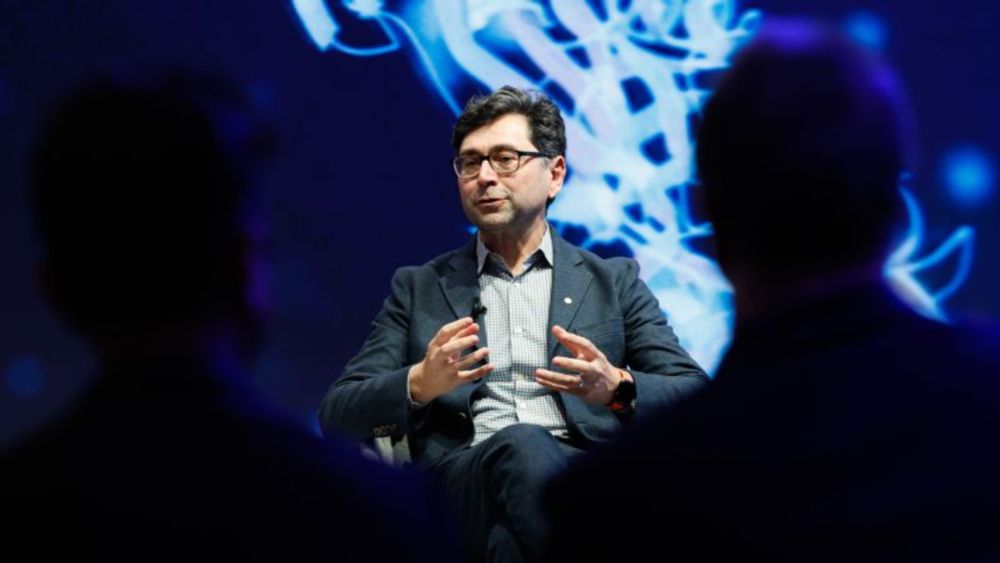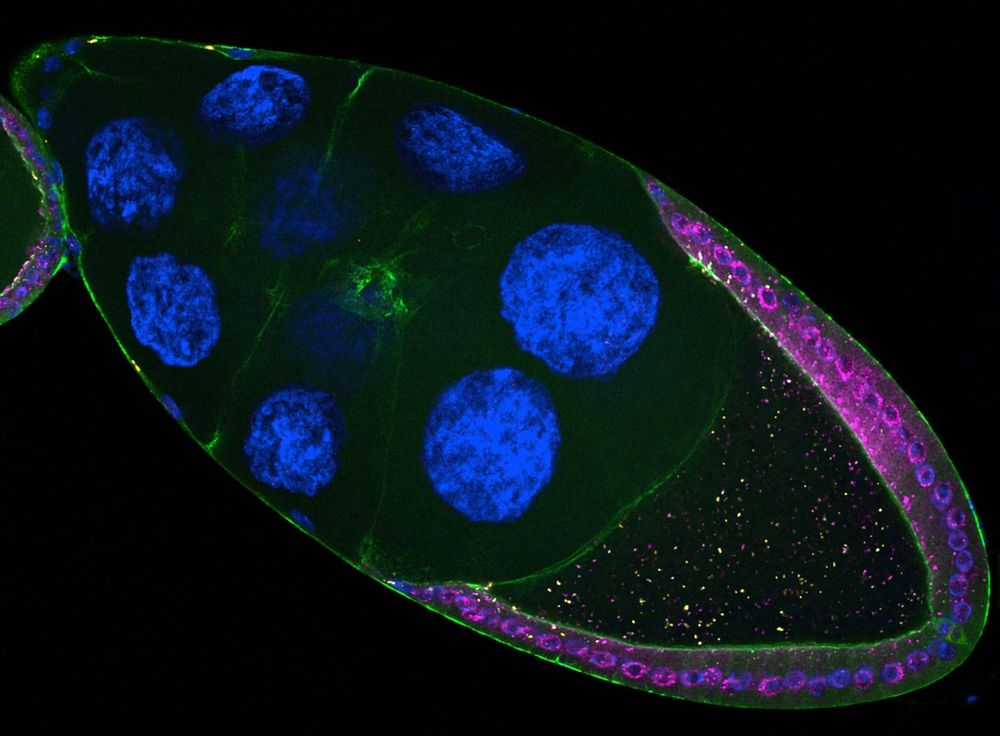
Overall, we propose that ecDNA is not only selected in cancer because of oncogenes, it is also actively retained because of retention elements, allowing it to persist in a growing cancer cell population. 11/11
13.10.2025 19:30 — 👍 0 🔁 0 💬 0 📌 0@kinglhung.bsky.social
Biologist at Scripps, PhD at Stanford. Dynamics of genomes and cells. https://kinglhung.org

Overall, we propose that ecDNA is not only selected in cancer because of oncogenes, it is also actively retained because of retention elements, allowing it to persist in a growing cancer cell population. 11/11
13.10.2025 19:30 — 👍 0 🔁 0 💬 0 📌 0
Finally, retention elements are unmethylated on ecDNA and when we methylate them, ecDNA becomes untethered from chromosomes. Plasmids with methylated retention elements are also no longer retained. 10/11
13.10.2025 19:30 — 👍 0 🔁 0 💬 1 📌 0We found that most ecDNAs in patient tumors contain retention elements. ecDNA size is much bigger than the oncogenes themselves but is anti-correlated with abundance of retention elements in the surrounding locus, suggesting selection of these elements in the retained ecDNA. 9/11
13.10.2025 19:30 — 👍 0 🔁 0 💬 1 📌 0Retention elements on ecDNA interact with previously identified mitotic bookmarks on chromosomes in chromatin conformation analysis, suggesting that retention elements may interact with chromosomes in mitosis via active DNA sites, potentially mediated by bookmarking factors. 8/11
13.10.2025 19:30 — 👍 0 🔁 0 💬 1 📌 0

Using live cell imaging, we found that adding a retention element to a plasmid makes it more likely to attach to chromosomes during mitosis. 7/11
13.10.2025 19:30 — 👍 0 🔁 0 💬 1 📌 0
We verified that these elements, when individually cloned into a plasmid, can promote retention of the plasmid in cells. Putting more copies of an element in a plasmid increases its retention additively. 6/11
13.10.2025 19:30 — 👍 0 🔁 0 💬 1 📌 0We found that many of the retained DNA elements, which we call “retention elements”, are active regulatory sequences such as promoters and enhancers. This was exciting to us because these are genomic sites where many DNA-binding proteins can interact with DNA. 5/11
13.10.2025 19:30 — 👍 0 🔁 0 💬 1 📌 0
To identify elements within ecDNA that may act as anchors for tethering, we shattered the entire human genome into short pieces of DNA, cloned them into a plasmid pool and asked which DNA pieces can be retained over many cell passages. 4/11
13.10.2025 19:30 — 👍 1 🔁 0 💬 1 📌 0
ecDNA does not have centromeres but is inherited along with chromosomes by tethering to them. Although this tethering phenomenon has been observed for many years, the mechanism is unknown. 3/11
13.10.2025 19:30 — 👍 0 🔁 0 💬 1 📌 0First, a great collaboration with Venkat Sankar, Howard Chang, Paul Mischel, Aditi Gnanasekar, Ivy Wong, and other great collaborators. 2/11
13.10.2025 19:30 — 👍 0 🔁 0 💬 1 📌 0
Oncogenes are often copy-number amplified on extrachromosomal DNA (ecDNA) in cancer. But how is ecDNA inherited by dividing cancer cells? In this preprint, we identify elements within ecDNA that promote its retention in dividing cells. 1/11
www.biorxiv.org/content/10.1...

Dear Fly Community, In May 2025, the NIH terminated all grant funding to Harvard University, including the NHGRI grant that supported FlyBase. This grant also funded FlyBase teams at Indiana University (IU) and the University of Cambridge (UK), and as a result, their subawards were also canceled. The Cambridge team has secured support for one to two years through generous donations from the European fly community, emergency funding from the Wellcome Trust, and support from the University of Cambridge. At IU, funding has been secured for one year thanks to reserve funds from Thom Kaufman and a supplement from ORIP/NIH to the Bloomington Drosophila Stock Center (BDSC). Unfortunately, the situation at Harvard is far more critical. Harvard University had supported FlyBase staff since May but recently denied a request for extended bridge funding. As a result, all eight employees (four full-time and four part-time) were abruptly laid off, with termination dates ranging from August to mid-October depending on their positions. In addition, our curator at the University of New Mexico will leave her position at the end of August. This decision came as a shock, and we are urgently pursuing all possible funding options. To put the need into perspective: although FlyBase is free to use, it is not free to make. It takes large teams of people and millions of dollars a year to create FlyBase to support fly research (the last NHGRI grant supported us with more than 2 million USD per annum). To help sustain FlyBase operations, we have been reaching out to you to ask for your support. We have set up a donation site in Cambridge, UK, to which European labs have and can continue to contribute, and a new donation site at IU to which labs in the US and the rest of the world can contribute. We urge researchers to work with their grant administrators to contribute to FlyBase via these sites if at all possible, as more of the money will go to FlyBase. However, we appreciate that some fu…

https://wiki.flybase.org/wiki/FlyBase:Contribute_to_FlyBase Our immediate goals are: 1. To maintain core curation activities and keep the FlyBase website online 2. To complete integration with the Alliance of Genome Resources (The Alliance). Integration with the Alliance is essential for FlyBase’s long-term sustainability. For nearly a decade, NHGRI/NIH has supported the unification of Model Organism Databases (MODs) into the Alliance, which we aim to achieve by 2028. Therefore, securing bridge funding to sustain FlyBase over the next three years is crucial for successful integration and the long-term access to FlyBase data. At present, our remaining funds will allow us to keep the FlyBase website online for approximately one more year. Beyond that, its future is uncertain unless new funding is secured. We will, of course, continue pursuing additional grant opportunities as they arise. Given the uncertainty of future NIH or alternative funding sources, we are relying on the Fly community for support. Your contributions will directly help us retain the staff needed to complete this transition and to secure ongoing fly data curation into the Alliance beyond 2028. We at FlyBase are incredibly grateful for the outpouring of support from the community during this challenging time. Your encouragement has strengthened our resolve and underscores how vital this resource remains to Drosophila research worldwide. Sincerely, The FlyBase Team
The community of Drosophila researchers is amazing, mutually supportive and collaborative. Right now a key resource for our community, @flybase.bsky.social , is threatened by the cancellation of its NIH grant and is seeking community help in raising short term funds 1/n 🧪 please share
23.08.2025 12:18 — 👍 152 🔁 128 💬 1 📌 8
Published an op-ed for @cnn.com: “Nobel laureate: I owe America my success. Today, its scientific future is in danger.”
A personal reflection on what’s at stake as science funding gets slashed. I’d be grateful if you could amplify both in and beyond the science world.
www.cnn.com/2025/04/09/h...

Cool approach to isolate extrachromosomal DNA: karyotyping by FACS! Wish I had thought of it. www.biorxiv.org/content/10.1...
28.03.2025 04:28 — 👍 2 🔁 0 💬 0 📌 0So excited for you, Rose!
27.03.2025 16:15 — 👍 2 🔁 0 💬 0 📌 0
Drosophila follicle showing retrotransposons (pink & yellow) expressed in somatic cells infecting the oocyte
1/ Transposable elements are often called "jumping genes" because they mobilize within genomes. 🧬
But did you know they can also jump 𝘣𝘦𝘵𝘸𝘦𝘦𝘯 cells? 🤯
Our new study reveals how retrotransposons invade the germline directly from somatic cells.
www.biorxiv.org/content/10.1...
A short thread 🧵👇
if you've had an NIH grant terminated, I want to hear about it. Signal: katherinejwu.12
07.03.2025 14:17 — 👍 495 🔁 384 💬 3 📌 7
The Patapoutian lab started 25 years ago on March 1, 2000. A quarter-century of science with brilliant trainees, colleagues & collaborators. Cheers to my mentors & mentees! Excited to celebrate with past & present lab members in November. Here’s to more great science 🧪 and better times ahead!
01.03.2025 15:14 — 👍 168 🔁 7 💬 10 📌 2Flooding BlueSky with good news today. Neal lab received a NoA! Grateful our NIH R35 MIRA renewal is funded to support our ongoing work on membrane protein quality! 🙏🙏
14.02.2025 23:28 — 👍 552 🔁 38 💬 27 📌 3Opportunity to work with an amazing scientist!
10.01.2025 01:52 — 👍 2 🔁 0 💬 0 📌 0Join our lab! We're hiring a research technician—a great opportunity for individuals with a Bachelor's degree who want to gain valuable research experience before heading to medical or graduate school.
recruiting2.ultipro.com/SCR1003TSRI/...
Thanks for highlighting our work!
19.11.2024 21:58 — 👍 0 🔁 0 💬 0 📌 0Also recently published work from this month:
bsky.app/profile/king...
Hi bluesky! A re-introduction: I am a cell biologist interested in cellular signaling logic and decision making. I worked on cancer genomes in my PhD at Stanford, and am now a postdoc working on how cells interpret force at Scripps in the Patapoutian lab. Excited to reconnect here!
19.11.2024 17:14 — 👍 15 🔁 1 💬 1 📌 0
Two back-to-back papers in Nature comms from mylab explore the link between destabilization of the actin cytoskeleton and aberrant base excision repair - passing through nuclear actin and the actin-dependent nucleosome remodeler INO80C.
15.11.2024 19:02 — 👍 81 🔁 26 💬 0 📌 2First re-post on @bsky.app . Great collaboration between @kinglhung.bsky.social and team eDyNAmiC !! 🔥🔥👇🏻👇🏻
18.11.2024 19:40 — 👍 4 🔁 3 💬 0 📌 0Lovely paper showing co-segregation and co-selection of multiple species of ecDNA within cancer cells. Nice computational modelling and inference of segregation and selection coefficients too @benjaminwerner.bsky.social and Weini Huang!
18.11.2024 19:41 — 👍 16 🔁 1 💬 0 📌 0@natureportfolio.bsky.social
18.11.2024 18:25 — 👍 0 🔁 0 💬 0 📌 0Thanks to Cancer Grand Challenges for supporting this project. Thank you also to all other collaborators who made this study possible, including Joshua Lange, Britney He, Jens Luebeck, Rachel Schmargon, Elisa Scanu, Lotte Brückner, Ben Werner, Weini Huang, Ben Cravatt, and Anton Henssen. 9/
18.11.2024 17:37 — 👍 1 🔁 0 💬 0 📌 0
Overall, these results show unique distribution and evolution of extrachromosomal oncogene copies in cancer cells. Co-inheritance allows cancer cells to keep specific combinations of DNA sequences, allowing the winning combination to get amplified in cancer. 8/
18.11.2024 17:37 — 👍 1 🔁 0 💬 1 📌 0